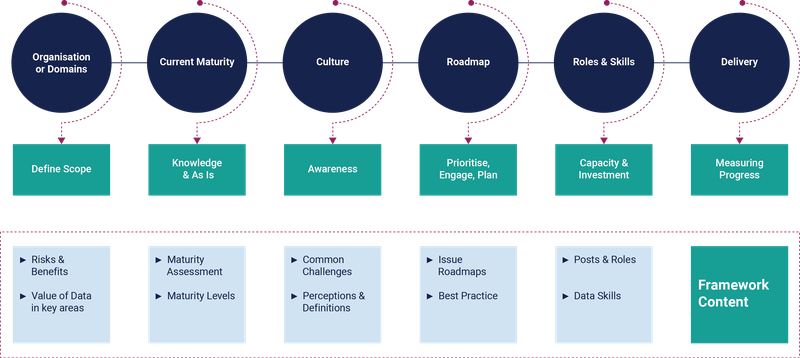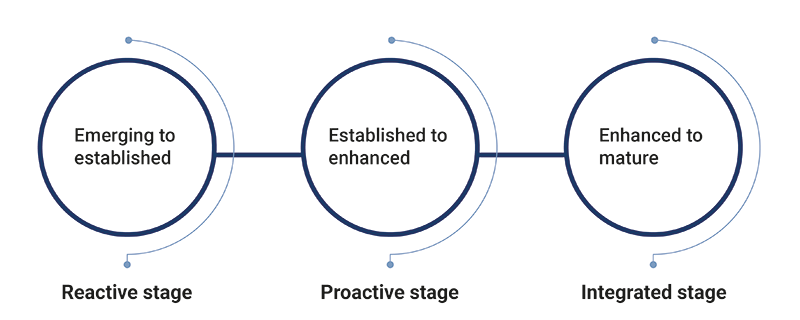Maturity journey
Embarking on any change activity is challenging, particularly in the highly devolved environments common in the FE and HE sectors.
The data maturity framework includes materials that will support you in this journey:

Alt text for maturity journey graphic
A graphic showing six areas in the data maturity framework.
- Organisation or domains - define scope - risks and benefits, value of data in key areas
- Current maturity - knowledge and as is - maturity assessment, maturity levels
- Culture - awareness - common challenges, perceptions and definitions
- Roadmap - prioritise, engage, plan - issue roadmaps, best practice
- Roles and skills - capacity and investment - posts and roles, data skills
- Delivery - measuring progress - framework content
A graphic showing six areas in the data maturity framework.
- Organisation or domains - define scope - risks and benefits, value of data in key areas
- Current maturity - knowledge and as is - maturity assessment, maturity levels
- Culture - awareness - common challenges, perceptions and definitions
- Roadmap - prioritise, engage, plan - issue roadmaps, best practice
- Roles and skills - capacity and investment - posts and roles, data skills
- Delivery - measuring progress - framework content
We encourage you to consider the scope of the work you are trying to improve and the risks/benefits of a domain versus organisation wide approach.
Ensure you have a clear understanding of your starting point through effective discovery activities. You may want to use the data maturity assessment or other Jisc support to help you at this stage.
Consider the culture of your organisation, how decisions are made, organisational values and the behaviours that may inhibit progress.
Use knowledge of your culture and current state to identify areas where improvement is either a priority (which will help with buy in and investment) or possible (which will help you prove your case through delivery).
Consider how improvements will be delivered – through existing people or teams or through investment in new roles or technology – and what those roles or investments might be.
Maturity levels

Alt text for maturity levels graphic
A graphic showing the three levels of maturity.
- Emerging to established - reactive stage
- Established to enhanced - proactive stage
- Enhanced to mature - integrated stage
A graphic showing the three levels of maturity.
- Emerging to established - reactive stage
- Established to enhanced - proactive stage
- Enhanced to mature - integrated stage
Multiple terms can be used to describe maturity levels at any level or area of an organisation.
The data maturity framework is built on three stages of maturity.
These are supplemented by two further stages that reflect the journey from reactive to proactive and from proactive to integrated. We use the terms Level 1 to Level 5 in the framework for clarity and simplicity:
| Description | Maturity level | Feels like |
|---|---|---|
| Reactive | L1 | Chaotic, unaware, defensive |
| Working towards proactive | L2 | Early, emerging, nascent |
| Proactive | L3 | Stable, managed, learning |
| Working towards integrated | L4 | Proactive, enhanced, developing |
| Integrated | L5 | Predictive, advanced, innovative |
How does your organisation look and feel?
| Description | Summary |
|---|---|
| L1 Reactive | No formal data management capability exists. Data is collected, stored and processed in an entirely operational context. Business processes are embryonic at best, while technology is very limited in use. Dealing with operation and change is difficult and the quality of outputs is not trusted. Culturally data is not viewed as important, or even understood. There are no repeatable processes to increase efficiency or reduce cost, no interest in dealing with potential legal data breaches, and no strategy or direction on how data management can support organisational goals. |
| L2 Working towards proactive | A nascent data management capability is emerging. Known outputs are supported by informal roles and simple business processes. Technology may be providing some point solutions. Change is still difficult to deal with but some trust in quality of key outputs is likely. The value of data is not likely to be well understood or advocated by non-IT staff although the value of outputs – especially statutory – obligations will be. There will be no real support for a data improvement plan or devolution of information accountability. A lack of data governance still puts the organisation at risk and a root cause analysis will continue to make maintaining quality problematic. |
| L3 Proactive | Data management is embedded for key datasets and statutory outputs. Roles have emerged and business processes reduce reliance on individuals. Data quality measurement will be patchy, focused on where information asset accountability has been devolved. Technology is likely to support some parts of the lifecycle. The value of data is likely to be championed in some sections of the organisation, but it will not have senior management interest except during periods of crisis. There is likely to be a push for the ‘single version of the truth’ but this is very difficult to achieve at a stable level because of the lack of reconciliation of data sets that ‘have gone wild’. |
| L4 Working towards integrated | Data management is a key organisational capability. Most outputs are automated and supported by rigorous and integrated business processes. Capacity for business change is available and likely delivered through some form of data architecture function. Services such as analytics are likely to be available or emerging as part of a technology set that is integrated with wider toolsets. Data and the value of it will be championed by at least one senior stakeholder and improvement plans will be embedded as part of daily operation. Data governance is likely to be formalised providing far greater control over the quality and mastering of core datasets, and data management roles are likely to be formally in place. |
| L5 Integrated | Data management has become a strategic capability. It is the foundation for the development of new and innovative services of which predictive analytics and sophisticated data linking are just two. Automation of all repeatable business processes is seamlessly integrated with business process and wider organisational operating models. Data architecture is fully fledged - models enable the upgrade of old services, and creation of entirely new ones. Technology will support operations and change as part of an integrated package of solutions. |
Domains
Addressing data capability at an organisational level may feel challenging. An alternative approach is to select a specific business area or data domain and use this as a vehicle to establish policies and practices to underpin other areas in the future.
The data maturity framework is copyright Jisc and made available under CC BY-NC-ND. Find out more about using content from the data maturity framework.